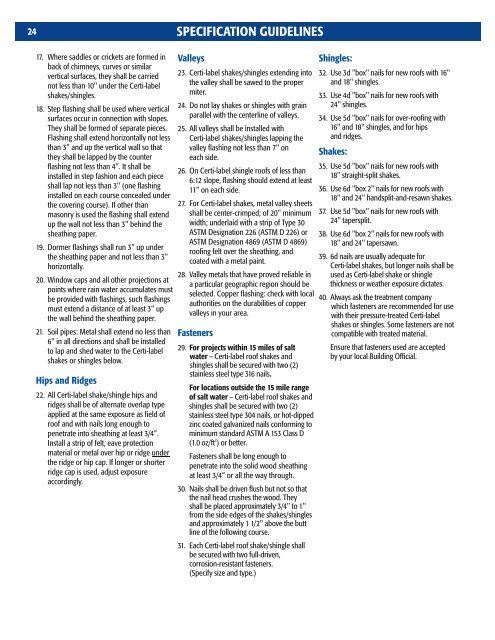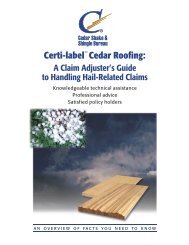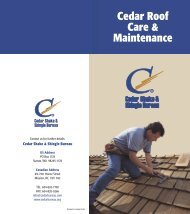New Roof Construction MANUAL - Cedar Shake and Shingle Bureau
New Roof Construction MANUAL - Cedar Shake and Shingle Bureau
New Roof Construction MANUAL - Cedar Shake and Shingle Bureau
Create successful ePaper yourself
Turn your PDF publications into a flip-book with our unique Google optimized e-Paper software.
24<br />
17. Where saddles or crickets are formed in<br />
back of chimneys, curves or similar<br />
vertical surfaces, they shall be carried<br />
not less than 10" under the Certi-label<br />
shakes/shingles.<br />
18. Step flashing shall be used where vertical<br />
surfaces occur in connection with slopes.<br />
They shall be formed of separate pieces.<br />
Flashing shall extend horizontally not less<br />
than 3" <strong>and</strong> up the vertical wall so that<br />
they shall be lapped by the counter<br />
flashing not less than 4". It shall be<br />
installed in step fashion <strong>and</strong> each piece<br />
shall lap not less than 3" (one flashing<br />
installed on each course concealed under<br />
the covering course). If other than<br />
masonry is used the flashing shall extend<br />
up the wall not less than 3" behind the<br />
sheathing paper.<br />
19. Dormer flashings shall run 3" up under<br />
the sheathing paper <strong>and</strong> not less than 3"<br />
horizontally.<br />
20. Window caps <strong>and</strong> all other projections at<br />
points where rain water accumulates must<br />
be provided with flashings, such flashings<br />
must extend a distance of at least 3" up<br />
the wall behind the sheathing paper.<br />
21. Soil pipes: Metal shall extend no less than<br />
6" in all directions <strong>and</strong> shall be installed<br />
to lap <strong>and</strong> shed water to the Certi-label<br />
shakes or shingles below.<br />
Hips <strong>and</strong> Ridges<br />
22. All Certi-label shake/shingle hips <strong>and</strong><br />
ridges shall be of alternate overlap type<br />
applied at the same exposure as field of<br />
roof <strong>and</strong> with nails long enough to<br />
penetrate into sheathing at least 3/4”.<br />
Install a strip of felt, eave protection<br />
material or metal over hip or ridge under<br />
the ridge or hip cap. If longer or shorter<br />
ridge cap is used, adjust exposure<br />
accordingly.<br />
SPECIFICATION GUIDELINES<br />
Valleys<br />
23. Certi-label shakes/shingles extending into<br />
the valley shall be sawed to the proper<br />
miter.<br />
24. Do not lay shakes or shingles with grain<br />
parallel with the centerline of valleys.<br />
25. All valleys shall be installed with<br />
Certi-label shakes/shingles lapping the<br />
valley flashing not less than 7" on<br />
each side.<br />
26. On Certi-label shingle roofs of less than<br />
6:12 slope, flashing should extend at least<br />
11” on each side.<br />
27. For Certi-label shakes, metal valley sheets<br />
shall be center-crimped; of 20" minimum<br />
width; underlaid with a strip of Type 30<br />
ASTM Designation 226 (ASTM D 226) or<br />
ASTM Designation 4869 (ASTM D 4869)<br />
roofing felt over the sheathing, <strong>and</strong><br />
coated with a metal paint.<br />
28. Valley metals that have proved reliable in<br />
a particular geographic region should be<br />
selected. Copper flashing: check with local<br />
authorities on the durabilities of copper<br />
valleys in your area.<br />
Fasteners<br />
29. For projects within 15 miles of salt<br />
water – Certi-label roof shakes <strong>and</strong><br />
shingles shall be secured with two (2)<br />
stainless steel type 316 nails.<br />
For locations outside the 15 mile range<br />
of salt water – Certi-label roof shakes <strong>and</strong><br />
shingles shall be secured with two (2)<br />
stainless steel type 304 nails, or hot-dipped<br />
zinc coated galvanized nails conforming to<br />
minimum st<strong>and</strong>ard ASTM A 153 Class D<br />
2<br />
(1.0 oz/ft ) or better.<br />
Fasteners shall be long enough to<br />
penetrate into the solid wood sheathing<br />
at least 3/4” or all the way through.<br />
30. Nails shall be driven flush but not so that<br />
the nail head crushes the wood. They<br />
shall be placed approximately 3/4" to 1"<br />
from the side edges of the shakes/shingles<br />
<strong>and</strong> approximately 1 1/2" above the butt<br />
line of the following course.<br />
31. Each Certi-label roof shake/shingle shall<br />
be secured with two full-driven,<br />
corrosion-resistant fasteners.<br />
(Specify size <strong>and</strong> type.)<br />
<strong>Shingle</strong>s:<br />
32. Use 3d "box" nails for new roofs with 16"<br />
<strong>and</strong> 18" shingles.<br />
33. Use 4d "box" nails for new roofs with<br />
24" shingles.<br />
34. Use 5d "box" nails for over-roofing with<br />
16" <strong>and</strong> 18" shingles, <strong>and</strong> for hips<br />
<strong>and</strong> ridges.<br />
<strong>Shake</strong>s:<br />
35. Use 5d "box" nails for new roofs with<br />
18" straight-split shakes.<br />
36. Use 6d "box 2" nails for new roofs with<br />
18" <strong>and</strong> 24" h<strong>and</strong>split-<strong>and</strong>-resawn shakes.<br />
37. Use 5d "box" nails for new roofs with<br />
24" tapersplit.<br />
38. Use 6d "box 2" nails for new roofs with<br />
18" <strong>and</strong> 24" tapersawn.<br />
39. 6d nails are usually adequate for<br />
Certi-label shakes, but longer nails shall be<br />
used as Certi-label shake or shingle<br />
thickness or weather exposure dictates.<br />
40. Always ask the treatment company<br />
which fasteners are recommended for use<br />
with their pressure-treated Certi-label<br />
shakes or shingles. Some fasteners are not<br />
compatible with treated material.<br />
Ensure that fasteners used are accepted<br />
by your local Building Official.





